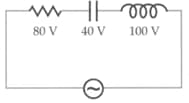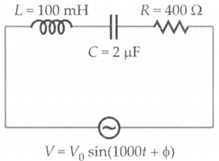S. L. Arora Solutions for Chapter: Alternating Current and Electrical Machines, Exercise 6: Problems For Practice
S. L. Arora Physics Solutions for Exercise - S. L. Arora Solutions for Chapter: Alternating Current and Electrical Machines, Exercise 6: Problems For Practice
Attempt the free practice questions on Chapter 1: Alternating Current and Electrical Machines, Exercise 6: Problems For Practice with hints and solutions to strengthen your understanding. PHYSICS A Reference Book for Class 12 Volume 2 solutions are prepared by Experienced Embibe Experts.
Questions from S. L. Arora Solutions for Chapter: Alternating Current and Electrical Machines, Exercise 6: Problems For Practice with Hints & Solutions
In the circuit shown in figure, the potential differences across resistance, capacitance and inductance are given. Find the emf of the source of alternating current and power factor of the circuit.

A group of electric bulbs has a power rating of . An a.c. voltage, is applied to the group. Calculate the effective current.
An alternating voltage and the corresponding current in a circuit are given by and respectively. Find the impedance and the average power dissipation in it.
An inductor , capacitor , resistor are connected in series with a , variable frequency a.c. source. Calculate the (i) frequency at which the power factor of the circuit is unity, (ii) current amplitude at this frequency, (iii) Q-factor.
An inductor of unknown value, a capacitor of and a resistor of are connected in series to a , a.c. source. It is found that the power factor of the circuit is unity. Calculate the inductance of the inductor and the current amplitude.
(i) Find the value of the phase difference between the current and the voltage in the series LCR circuit shown below. Which one leads in phase: current or voltage?

(ii) Without making any other change, find the value of the additional capacitor , to be connected in parallel with the capacitor C, in order to make the power factor of the circuit unity.
A circuit containing a inductor and a capacitor in series is connected to a , supply. If the circuit has a resistance of , obtain the average power transferred to each element of the circuit and the total power absorbed.
A resistor and an element are connected in series to an ac source of voltage. The voltage is found to lead the current in phase by . If X is replaced by another element, the voltage lags behind the current by .
(i) Identify elements and .
(ii) When both and are connected in series with to the same source, will the power dissipated in the circuit be maximum or minimum? Justify your answer.
